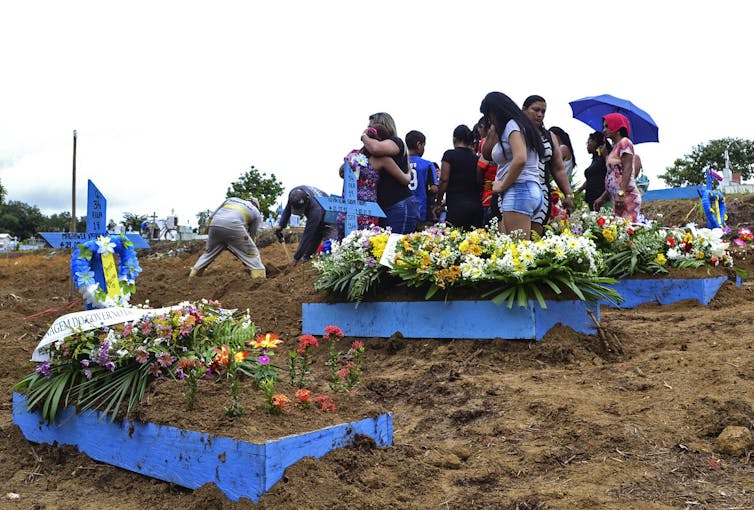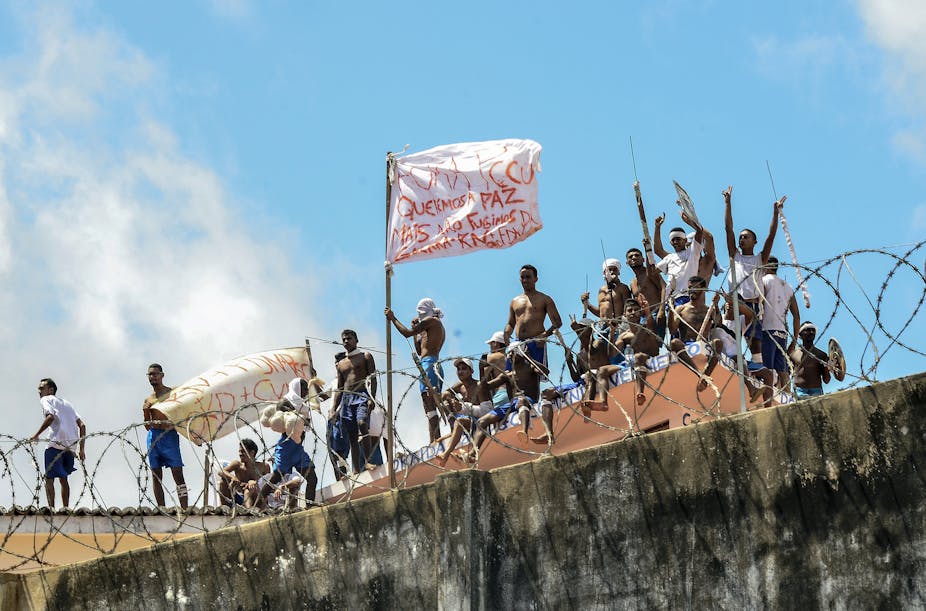The legitimacy of the Brazilian prison system has come in for deep scrutiny following a series of violent encounters between rival gangs in the north of the country. It started on January 1 when 56 inmates affiliated to the country’s largest criminal gang, São Paulo’s First Command of the Capital (PCC), were murdered at the Anísio Jobim complex in Manaus. Since then, more than 110 inmates have lost their lives in conflicts across a number of prisons over who controls those spaces.
The mass killings followed a number of smaller, yet equally violent encounters between the PCC and its northern rivals in October 2016, when another 21 prisoners died. In each incident, the victors’ new territory has been marked by the mutilated bodies of their victims.
Brazil’s president, Michel Temer, continues to be criticised for denying the full implications of the massacres. In particular, critics claim the violent events are not exceptional events but symptoms of a system in continuous crisis.
In an recent article, anthropologist Chris Garces and I looked at the three underlying factors being blamed for the riots: the historically inhumane, overcrowded living conditions of the average Brazilian prison; a failure to prevent criminal gangs from spreading throughout the prison system; and the recent breakdown in relations between the PCC and Rio de Janeiro’s Red Command (CV), Brazil’s second largest criminal gang, over the trade in cocaine.
By controlling prisons, gangs indirectly control the drugs trade outside prison. Gangs do not typically sell drugs themselves but through a system of franchising, or licensing. When someone purchases drugs from a gang on licence and does not repay their debts, they know there will be nowhere to hide the day they end up in prison.
Faxina running the wings
But the crisis is also a temporary breakdown in a long-established order. The riots have disrupted a decades-old system of “co-produced” governance that has kept Brazilian prisons in order and enabled the average Brazilian inmate to survive their prison experience.
Central to my understanding of Brazilian prison order is prison staff shortages. Historically, Brazilian prison administrators have never employed sufficient staff to run their establishments without the full cooperation of prisoners. Out of this grew a reliance on the inmate faxina or cleaner. Faxina were described in the 1953 autobiographic account of writer Graciliano Ramos of his time served as a political prisoner in Candido Mendes prison, Rio de Janeiro, and by Drauzio Varella’s 1991 account of everyday life at Carandiru prison, São Paulo, where he worked as a doctor. In both prisons, faxina were responsible for daily routines such as cleaning and distributing meals. They also worked alongside or in place of prison guards, helping to maintain order and security. Candido Mendes and Carandiru were the birth places of the CV and the PCC gangs.
In the past 30 years Brazil’s prison population has exploded, from a recorded 37,071 prisoners in 1984 to 622,731 prisoners in 2014. At the same time, staff-inmate ratios have decreased to the point where it is usual for one guard to be on duty for every 200 or 300 prisoners.
Prison staff have naturally come to rely even further on prisoners to self-govern. As in other parts of Latin America, prisoners have in turn had to become more and more organised to survive. In the new era of mass prison gangs, guards have little need to enter the cellblocks apart from to unlock and lockup in the morning and evening. In some prisons, even this most basic of prison officer function is being replaced with the use of electronic gates.
Of course, Brazilian prisoners still continue to rely on prison staff, but the relationship between them is largely reciprocal and negotiated. In some of the prisons I have researched or visited, including prisons run by the PCC, prison governors approve faxina that have been chosen by the leaders of prison gangs.
It is no coincidence that no prison staff have died in the recent rebellions. The breakdown in order is the cause of a rift in criminal gang relations, not prisoner-staff relations.

Brazil, then, has a long history of inmate governance and staff-prisoner collaboration that ordinarily maintains order – and survival. But this has temporarily broken down as the two big gangs compete for territory in northern Brazil.
Gangs keeping prisons safer
For inmates at the top of prison hierarchies, this co-produced order allows them to make money from drugs. But the common prisoner is more concerned with everyday order: they want prison gangs to make their lives more predictable, protect them, and provide for their needs.
With the Brazilian state increasingly failing to do this, prison gangs are stepping in to fill the void. The PCC is the most advanced of these prisoner organisations – and the most successful at keeping order. In ground-breaking recent studies, anthropologists Karina Biondi and Adalton Marques demonstrated that through its regulation of illicit markets, banning of weapons and drugs other than cannabis, provision and enforcement of regulas de convivencia (rules of coexistence), the PCC has actually made São Paulo’s prisons the safest in the country.
There is little the Brazilian authorities can do in response to the recent wave of rebellions in the short term. They will wait for the crisis to run its course. When the northern dispute between the PCC and CV is settled, Temer can rest assured that it will be back to business as usual. Prison rebellions are no more in the interests of prisoners than prison authorities. Temer might also hope that the PCC one day controls the whole of the prison system.

